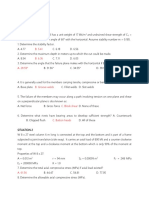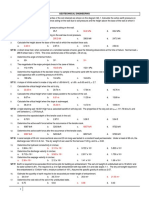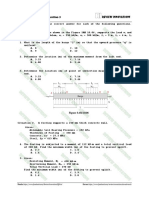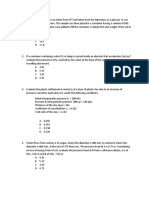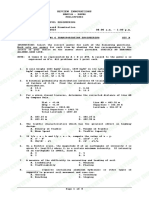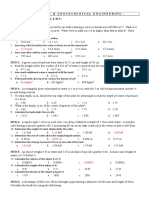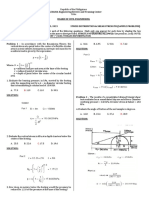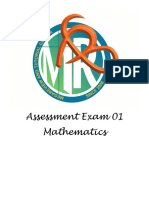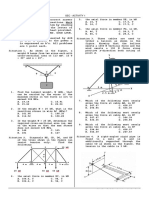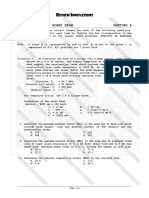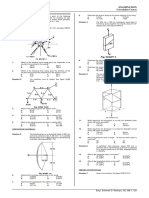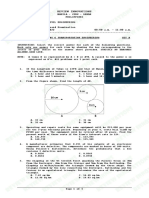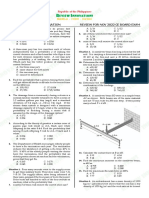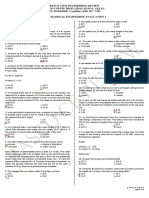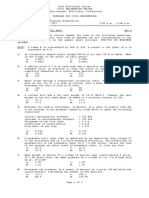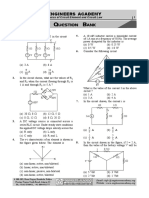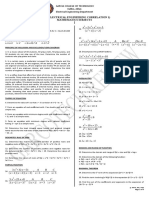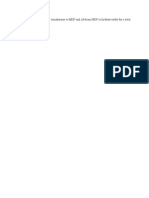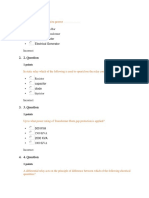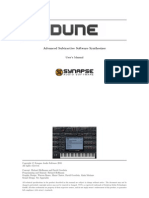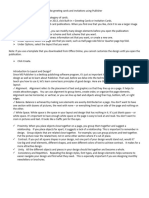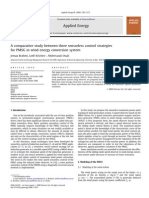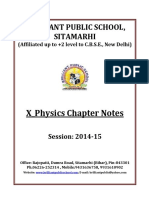Hge Pre-Board Questionnaire
Hge Pre-Board Questionnaire
Uploaded by
gregCopyright:
Available Formats
Hge Pre-Board Questionnaire
Hge Pre-Board Questionnaire
Uploaded by
gregOriginal Description:
Original Title
Copyright
Available Formats
Share this document
Did you find this document useful?
Is this content inappropriate?
Copyright:
Available Formats
Hge Pre-Board Questionnaire
Hge Pre-Board Questionnaire
Uploaded by
gregCopyright:
Available Formats
RASCO CIVIL ENGINEERING REVIEW
ALOJA COFFEE SHOP, LIBAS, BANGA, AKLAN
CP: 09164618841 / Landline: (036) 267 - 7343
HYDRAULICS AND GEOTECHNICAL ENGINEERING – PREBOARD NO. 1
SUBJECT: HYDRAULICS AND GEOTECHNICAL ENGINEERING Situation 4 (10-12). A rectangular footing, 3 m x 4 m in plan, is founded
TIME LIMIT: 4 HOURS PASSING: 70% 1.2 m below the ground surface for which the bulk unit weight of the soil
is 20 kN/m^3, the unconfined compressive strength is 10 kPa, and the
SET A angle of internal friction is 20 deg. Under the condition of general shear
failure (with Nc=17.69, Nq=7.44, Ny=3.64), evaluate the contribution of
Situation 1 (1-3) According to the elastic theory, the vertical stress the following to the ultimate bearing capacity, in kPa.
induced by flexible line load of infinite length that has an intensity of q
units/length on the surface of a semi-infinite soil mass can be estimated 10. Cohesion strength
by the expression: a. 216.70 c. 108.35 kPa
b. 210.42 d. 332.22
P=0.637 (q/N) where
11. soil overburden
N=Z[1 + (r/z)^2]^2 a. 344.7 c. 178.56
b. 419.2 d. 169.8
r=horizontal distance from the line load
z=depth of interest at which stress is induced 12. footing dimension
a. 61.47 c. 36.81
A concrete hollow block wall weighing 6 kN per lineal meter is carried by b. 92.82 d. 97.45
a wall footing 0.6 m wide. Evaluate
13. For the value of the atmospheric pressure at sea level used in
1. Bearing pressure (kPa) exerted by the footing onto the supporting soil engineering practice, evaluate how high (m) is the atmosphere above sea
a. 10 c. 30 level?
b. 20 d. 40 a. 10 000 c. 8500
b. 9500 d. 7500
2. stress (kPa) in the soil caused by the load depth equal to twice its width
a. 4.67 c. 5.31 14. An airplane flying at an altitude of 10 km dropped to a height of 6 km.
b. 2.50 d. 3.45 What is the corresponding change in pressure (kPa)? Unit weight of air is
12 kN/m^3
3. stress at a depth of 2 m and a horizontal distance 3 m from the line load a. 48 c. 480
a. 0.302 c. 0.318 b. 48 000 d. 4800
b. 0.210 d. 0.474
Situation 5 (15-17)A jet of water 75 mm dia and moving to the right
Situation 2 (4-6) A triangular gate with height of 0.9 m and base width of impinges on a flat plate held normal to its axis. If the velocity of the jet is
1.2 m is inclined 60 degrees with the horizontal with the vertex at the top 25 m/s, compute
and the base parallel with the water surface. The vertex is 2 m below the
water surface. Compute 15. the force (kN) that will keep the plate in equilibrium
a. 3.87 c. 4.27
4. Total hydrostatic force (N) acting on one side of the gate b. 2.48 d. 2.76
a. 15.87 c. 12.36
b. 10.21 d. 13.35 16. if the plate was moving to the right with a velocity of 9 m/s, what force
(kN) would the jet exert on the plate?
5. location (m) of the total hydrostatic force from the vertex of the gate. a. 3.33 c. 1.13
a. 0.725 c. 0.684 b. 1.02 d. 2.17
b. 0.615 d. 0.684
17. had the plate been moving to the left at 9 m/s, what force (kN) would
6. If the base is hinged, what normal force (kN) at the vertex is needed to the jet exert on the plates?
open the gate? a. 4.25 c. 4.68
a. 4.22 c. 6.32 b. 5.24 d. 5.11
b. 5.24 d. 3.54
18. A layer of soft clay having an initial void ratio of 2 is 10 m thick. Under
Situation 3 (7-9) A trapezoidal canal has a bottom width of 6 m and a side a compressive load applied above it, the void ratio decreased by one-half.
slope 2 horizontal to 1 vertical. When the depth of the flow is 1.2 m and Evaluate the reduction in the thickness of the clay layer (m).
the rate of flow is 20.4 m^3/s. Solve a. 4.67 c. 3.33
b. 2.50 d. 3.45
7. the specific energy (m)
a. 1.23 m c. 2.32 m Situation 6 (19-21) A sample of saturated clay has a water content of 56%.
b. 1.41 m d. 2.75 m Assume Gs=2.72, solve
8. if the roughness coefficient n = 0.015, obtain the slope of the canal 19. Void ratio
using Manning’s Formula a. 1.63 c. 1.4
a. 0.00094 c. 0.00074 b. 1.52 d. 1.29
b. 0.0011 d. 0.00033
20. saturated unit weight (lb/ft^3)
9. compute the average shearing stress at the boundary over the surface a. 171.34 c. 105.16
of the channel (N/m^2) b. 111.24 d. 134.09
a. 8.2 c. 5.23
b. 10.12 d. 9.57 21. porosity (%)
a. 45.98 c. 60.3
b. 27.77 d. 78.9
g. rasco, ce, rmp, ree
Page 1 of 3
RASCO CIVIL ENGINEERING REVIEW
ALOJA COFFEE SHOP, LIBAS, BANGA, AKLAN
CP: 09164618841 / Landline: (036) 267 - 7343
HYDRAULICS AND GEOTECHNICAL ENGINEERING – PREBOARD NO. 1
22. A rectangular plate is submerged vertically in two layers of liquids. Situation 10 (33-35) An 8.6 m thick clay layer is overlain by 15.2 m of sand
Half of the plate is submerged in water and the other half in oil (G=0.84). to the ground. The water table is level with the ground surface. The
The top of the gate is flushed with liquid surface. Obtain the ratio of the saturated unit weight of sand is 21.2 kN/m^3 and its dry unit weight is
force of water to the force of oil. 18.2 kN/m^3. The saturated unit weight of clay is 18.8 kN/m^3. The water
a. 3.25 c. 3.19 table is lowered to 7.6 m below the ground and the sand above the water
b. 3.75 d. 3.52 table have a degree of saturation lowered to 30%. Solve
Situation 7 (23-25) According to Section 304.2 of NSCP, the designated 33. The effective pressure (kPa) at the midheight of the clay layer before
allowable foundation pressure of 75 kPa (in Table 304-1 of NSCP) is for the lowering of the water table
footing having a minimum footing width of 300 mm and minimum depth a. 207 c. 256
of 300 mm into the natural grade. An increase of 20% is allowed for each b. 324 d. 212
additional 300 mm of width and/or depth to a maximum value of three
times the designated value. Calculate: 34. The effective pressure (kPa) at the midheight of the clay layer after
the lowering of the water table
23. allowable foundation pressure (kPa) of square footing 1.20 m in width a. 261 c. 236
and 300 mm in depth. b. 277 d. 270
a. 135 c. 105
b. 120 d. 150 35. The effective pressure (kPa) at the midheight of the clay layer when
the water table is at the clay surface and assuming that all sand has the
24. allowable foundation pressure (kPa) of square footing 1.20 m in width same degree of saturation
and 900 mm in depth. a. 314.7 c. 347.3
a. 135 c. 105 b. 329 d. 369.8
b. 120 d. 150
Situation 11 (36-38) A vertical triangular gate 0.9 m high have its 2 m base
25. From the previous question, solve the safe load (kN) on top of the flushed with the water surface. Determine
footing.
a. 194 c. 288 36. Total force acting on one side of the gate (kN)
b. 324 d. 216 a. 5.3 c. 1.25
b. 1.25 d. 2.65
Situation 8 (26-28) A circular gate 1.5 m in dia is inclined at an angle of 45
deg. Fresh water stands on one side of the gate to a height of 10 m above 37. location of the center of pressure from the top
the center of the gate. Evaluate a. 0.3 m c. 0.2 m
b. 0.45 m d. 0.25 m
26. Total force (kn) on the gate
a. 173.4 c. 183.05 38. eccentricity (m)
b. 134.6 d. 288.36 a. 0.15 c. 0.10
b. 0.63 d. 0.20
27. Locate the point of action (m) of the total force from the bottom on
the plane of the gate Situation 12 (39-41) A cylinder having a diameter of 1.2 m and weighing
a. 0.74 c. 0.45 800 N is held in position in sea water by a wire tied to an anchor block
b. 0.56 d. 0.28 resting at the bottom of the sea such that 0.30 m of the cylinder is below
the surface of the water with its axis vertical. The anchor block has a
28. If the gate is hinged at the top, evaluate the force (kN) normal to the volume of 0.5 m^3 and weighs 24 kN per cu. m in air. Assume sea water
gate at the bottom that will require to open it to have a specific gravity=1.03, neglecting the weight and volume of the
a. 33.22 c. 101.78 cable. Determine
b. 94.47 d. 87.80
39. Buoyant force on the cylinder for the position described, kN
Situation 9 (29-31) In a tri-axial test for normally consolidated soil, the a. 1.33 c. 6.89
normal stress at failure is equal to 450 kPa and the shear stress at failure b. 3.43 d. 2.78
is equal to 300 kPa. Compute
40. tensile force in the wire when the top of the cylinder is 0.60 m above
29. Angle of friction (degrees) the water surface, kN
a. 35.28 c. 33.69 a. 1.23 c. 2.75
b. 17.36 d. 38.98 b. 2.63 d. 5.78
30. angle of the failure plane with the major principal axis (degrees) 41. rise in the tide that will lift the anchor from the bottom of the sea, m
a. 56 c. 62 a. 0.38 c. 0.25
b. 77 d. 77 b. 0.73 d. 0.63
31. maximum principal stress at failure (kPa) Situation 13 (42-44) A 300 mm dia test well penetrates 27 m below the
a. 1567 c. 1013 static water table. After 24 hours of pumping at 69 li/s, the water level in
b. 1333 d. 978 an observation well at a distance of 95 m from the test well is lowered 0.5
m and the other observation well at a distance of 35 m from the test well,
32. What is the unit weight (N/m^3) of dry air at standard temperature the water level dropped by 1.1 m. Determine
and pressure?
a. 12.5 c. 10.6 42. Rate of flow in m^3/day
b. 11.3 d. 15.3 a. 5961.6 c. 5834.3
b. 9546.4 d. 9423.3
g. rasco, ce, rmp, ree
Page 2 of 3
RASCO CIVIL ENGINEERING REVIEW
ALOJA COFFEE SHOP, LIBAS, BANGA, AKLAN
CP: 09164618841 / Landline: (036) 267 - 7343
HYDRAULICS AND GEOTECHNICAL ENGINEERING – PREBOARD NO. 1
43. coefficient of permeability of the aquifer in m/day
a. 51.34 c. 60.27
b. 11.24 d. 34.09
44. transmissibility of the aquifer in m^2/day
a. 1633 c. 1894
b. 1579 d. 2491
45. What height in meters of a column of special gage liquid having a
G=2.90 would exert the same pressure as a column of oil 6 m high having
G=0.80?
a. 2.11 c. 0.96
b. 1.66 d. 1.45
46. Section 302.4.5 of the NSCP provides that slope of fill surface shall be
no steeper than is safe for its intended use and shall not be steeper than
__
a. 1:2 c. 1.5:2
b. 1:1 d. 1:3
47. A hydraulic jack is used to raise a 10 kN car. A force of 40 kN is applied
on a 25 cm dia plunger. What dia of jack in mm is required to raise the
car?
a. 300 c. 150
b. 125 d. 100
48. A cohesive soil deposit is considered soft if the unconfined
compression strength in kPa is between.
a. 0 to 24 c. 96 to 192
b. 48 to 96 d. 24 to 48
49. A barge weighing 350 kN when empty is 6 m wide, 15 m long and 3 m
high. Floating upright, evaluate the draft of the barge (m) when
transporting 5000 bags of cement along a river, each bag having a mass
of 40 kg. Assume the specific gravity of the water in the river to be 1.02.
a. 1.75 c. 2.57
b. 1.33 d. 3.56
50. A flow in which the velocity of the fluid at a particular fixed point does
not change with time.
a. steady c. laminar
b. continuous d. turbulent
***END***
g. rasco, ce, rmp, ree
Page 3 of 3
You might also like
- Assessment Exam 02Document7 pagesAssessment Exam 02Andrea Magtuto100% (1)
- Set ADocument12 pagesSet ADan Casurao0% (1)
- Hge Mid PreboardDocument7 pagesHge Mid PreboardChrisneil Delosreyes0% (1)
- Quiz 4 Experts - Soil Mech PartDocument4 pagesQuiz 4 Experts - Soil Mech PartBenjamin Benicarlo Juanillo IIINo ratings yet
- RC 3Document4 pagesRC 3Mayya BonaNo ratings yet
- 2019 Hyd MayDocument13 pages2019 Hyd MayChantal Faye GacusanNo ratings yet
- Kippap-Handout-SEC (40 RCD - Footings)Document10 pagesKippap-Handout-SEC (40 RCD - Footings)top1echolocoNo ratings yet
- PSAD 4 May 5 2023Document19 pagesPSAD 4 May 5 2023Renne Jude Rollorata100% (1)
- November 2021 Ce Board Exam Tuzon 6: Eview NnovationsDocument3 pagesNovember 2021 Ce Board Exam Tuzon 6: Eview NnovationsamberNo ratings yet
- Eval 1 Review May 2021Document4 pagesEval 1 Review May 2021Kiesha SantosNo ratings yet
- 2022 Nov Final Preboard MathDocument8 pages2022 Nov Final Preboard MathJOHN CARLO DE GUZMAN AMBAY (JCDGA)No ratings yet
- Refresher HYD Part2Document2 pagesRefresher HYD Part2Lionel LapuzNo ratings yet
- CE EVALUATION EXAM No. 6 - Channels, Weir, Hydrodynamics, Soil Prop (Answer Key)Document7 pagesCE EVALUATION EXAM No. 6 - Channels, Weir, Hydrodynamics, Soil Prop (Answer Key)Angelice Alliah De la Cruz100% (1)
- Hydrau 4Document3 pagesHydrau 4Mayya BonaNo ratings yet
- Two Open TanksDocument10 pagesTwo Open TanksMaverick TimbolNo ratings yet
- AlgebraDocument2 pagesAlgebramenma chanNo ratings yet
- Republic of The Philippines: Battery - 1Document9 pagesRepublic of The Philippines: Battery - 1Michael James ll BanawisNo ratings yet
- F2F Handouts (Stress Distribution & Shear Strength of Soil) - SOLUTIONS & ANSWERSDocument5 pagesF2F Handouts (Stress Distribution & Shear Strength of Soil) - SOLUTIONS & ANSWERSSelling AqwNo ratings yet
- Tos 2Document4 pagesTos 2Mayya BonaNo ratings yet
- Apr 2024 Preboard 1 HgeDocument3 pagesApr 2024 Preboard 1 HgeChrisjohn Dela Cruz100% (1)
- Hydrau 5Document3 pagesHydrau 5Mayya Bona0% (1)
- Hydraulics 3 Part 2Document1 pageHydraulics 3 Part 2YeddaMIlaganNo ratings yet
- Kippap AnswerKey Steel1Document3 pagesKippap AnswerKey Steel1Rene TeNo ratings yet
- Assessment Exam 01Document6 pagesAssessment Exam 01Andrea MagtutoNo ratings yet
- Eval 2 November 2022 Batch 1 WDDocument6 pagesEval 2 November 2022 Batch 1 WDMhiaBuenafeNo ratings yet
- Second Preboard Exam - MsteDocument8 pagesSecond Preboard Exam - MsteCzatrina Quintas100% (1)
- Sec - PS1Document2 pagesSec - PS1Monica Amor AbengozaNo ratings yet
- Preboard - With AnswersDocument4 pagesPreboard - With AnswersPrince HernandezNo ratings yet
- Preboard Examination 1 - Structural Engineering (Set A) : Situation 6Document4 pagesPreboard Examination 1 - Structural Engineering (Set A) : Situation 6Jaycee Uy0% (1)
- Ce November 2021 Refresher Pantino 4 Sec PDFDocument4 pagesCe November 2021 Refresher Pantino 4 Sec PDFYoshjordan LambNo ratings yet
- Calculus Problem SetDocument1 pageCalculus Problem SetJoyce DueroNo ratings yet
- I MB V: CE Review For Nov 2022 - Hydraulics 4Document2 pagesI MB V: CE Review For Nov 2022 - Hydraulics 4Jocelyn CabarlesNo ratings yet
- CE Board Nov 2020 - Plane and Solid Geometry - Set 3Document2 pagesCE Board Nov 2020 - Plane and Solid Geometry - Set 3Mark Lester Lualhati100% (1)
- Quiz #3 - Eng'g MechanicsDocument4 pagesQuiz #3 - Eng'g MechanicsAnthony Jay PoraqueNo ratings yet
- Q P A Q 1600 4 (4) Q 100 Kpa: SolutionDocument8 pagesQ P A Q 1600 4 (4) Q 100 Kpa: SolutionFrancis John Buac100% (1)
- Eview Nnovations May 2022 Ce Board Exam RENDON 6 (Hydraulics)Document3 pagesEview Nnovations May 2022 Ce Board Exam RENDON 6 (Hydraulics)Kian InductivoNo ratings yet
- Msteeeeapr 24Document9 pagesMsteeeeapr 24arjiiicryptNo ratings yet
- Preboard 2 GeoDocument4 pagesPreboard 2 GeoLienardNo ratings yet
- Assignment - IiDocument5 pagesAssignment - IichritNo ratings yet
- Problem 1 Problem 8:: Dy DX y 3e - 5 2 e + 8 LN 5xDocument6 pagesProblem 1 Problem 8:: Dy DX y 3e - 5 2 e + 8 LN 5xPrince Winderic G. Aclan100% (1)
- 2022 Nov Ce Preboard 1 MathDocument5 pages2022 Nov Ce Preboard 1 Mathrhoge hogeNo ratings yet
- MEGAREVIEW HGE Terms RefresherDocument2 pagesMEGAREVIEW HGE Terms RefresherDarlene Delos Santos100% (1)
- Refresher Module 04 - M6 - Intermodal Transportation SystemDocument1 pageRefresher Module 04 - M6 - Intermodal Transportation SystemKiki Do youNo ratings yet
- JIMBO Preboards 2 SolutionDocument3 pagesJIMBO Preboards 2 SolutionClark Sibi100% (1)
- Assessment Examination 02 PDFDocument28 pagesAssessment Examination 02 PDFJin Jae BasbasNo ratings yet
- Rendon 4 - Refresher HYDDocument2 pagesRendon 4 - Refresher HYDMigaeaNo ratings yet
- Concrete 1 November 2022Document4 pagesConcrete 1 November 2022Meverlyn Roquero100% (1)
- Soil 7 April 2023 1 of 2Document1 pageSoil 7 April 2023 1 of 2Nica SudamaNo ratings yet
- Republic of The Philippines: Set - ADocument4 pagesRepublic of The Philippines: Set - AAnthony Jay Poraque0% (1)
- Ri Engineering Econ 2 CompressDocument1 pageRi Engineering Econ 2 CompressMel Macairy NavarroNo ratings yet
- Eview Nnovations: First Evaluation Examination Review For Nov 2022 Ce Board ExamDocument2 pagesEview Nnovations: First Evaluation Examination Review For Nov 2022 Ce Board Examaja ø100% (1)
- At 14 2Document7 pagesAt 14 2Icz Fuentes100% (1)
- Rasco Civil Engineering Review Aloja Coffee Shop, Libas, Banga, Aklan CP: 09164618841 / Landline: (036) 267 - 7343 Fluid Mechanics - Evaluation 4Document3 pagesRasco Civil Engineering Review Aloja Coffee Shop, Libas, Banga, Aklan CP: 09164618841 / Landline: (036) 267 - 7343 Fluid Mechanics - Evaluation 4Greg Rasco, REE, RMPNo ratings yet
- Eval 3 AnsDocument3 pagesEval 3 AnsGreg Rasco, REE, RMPNo ratings yet
- Geo - 3Document2 pagesGeo - 3mammasddNo ratings yet
- Eval 2 FinalDocument4 pagesEval 2 FinalGreg Rasco, REE, RMPNo ratings yet
- Eval2 QuestionnaireDocument4 pagesEval2 QuestionnairegregNo ratings yet
- Q 1 EnggDocument3 pagesQ 1 EnggAlex NavalNo ratings yet
- Local Media3983018567083363738Document6 pagesLocal Media3983018567083363738Venus Kate GevaNo ratings yet
- Prepared By: Engr. Rolando A. Bitagun JR., ME-CE USL 2019-2020Document4 pagesPrepared By: Engr. Rolando A. Bitagun JR., ME-CE USL 2019-2020Jerome AdduruNo ratings yet
- Eval 3 - Ce - QuestionnaireDocument4 pagesEval 3 - Ce - QuestionnairegregNo ratings yet
- Lab 1Document5 pagesLab 1gregNo ratings yet
- Lab 2Document2 pagesLab 2gregNo ratings yet
- Lab 3Document3 pagesLab 3gregNo ratings yet
- Evaluation 1Document2 pagesEvaluation 1gregNo ratings yet
- Evaluation 1 QuestionnairesDocument4 pagesEvaluation 1 QuestionnairesgregNo ratings yet
- Rasco Civil Engineering Review Aloja Coffee Shop, Libas, Banga, Aklan CP: 09164618841 / Landline: (036) 267 - 7343 Algebra 2Document5 pagesRasco Civil Engineering Review Aloja Coffee Shop, Libas, Banga, Aklan CP: 09164618841 / Landline: (036) 267 - 7343 Algebra 2gregNo ratings yet
- Rasco Civil Engineering Review Aloja Coffee Shop, Libas, Banga, Aklan CP: 09164618841 / Landline: (036) 267 - 7343 Analytic GeometryDocument3 pagesRasco Civil Engineering Review Aloja Coffee Shop, Libas, Banga, Aklan CP: 09164618841 / Landline: (036) 267 - 7343 Analytic GeometrygregNo ratings yet
- Eval2 QuestionnaireDocument4 pagesEval2 QuestionnairegregNo ratings yet
- ESE Questions Bank EE NetworkDocument12 pagesESE Questions Bank EE NetworkgregNo ratings yet
- 2x +X +x+5 (X +1) (X 2) : Ee 412 (Electrical Engineering Correlation 1) Mathematics SubjectsDocument4 pages2x +X +x+5 (X +1) (X 2) : Ee 412 (Electrical Engineering Correlation 1) Mathematics SubjectsgregNo ratings yet
- The Standard Says, 2% From Transformer To MDP and 3% From MDP To Farthest Outlet For A Total of 5% Voltage DropDocument1 pageThe Standard Says, 2% From Transformer To MDP and 3% From MDP To Farthest Outlet For A Total of 5% Voltage DropgregNo ratings yet
- Buchholz Relays Are Used To ProtectDocument5 pagesBuchholz Relays Are Used To ProtectgregNo ratings yet
- Vom Practical QuestionsDocument14 pagesVom Practical QuestionsgregNo ratings yet
- Practical Questions OscilloscopeDocument16 pagesPractical Questions OscilloscopegregNo ratings yet
- Major Faults in An Alternator and Their ProtectionDocument13 pagesMajor Faults in An Alternator and Their Protectiongreg100% (2)
- Plumbing TestDocument2 pagesPlumbing TestgregNo ratings yet
- Instrumentation PrefinalDocument15 pagesInstrumentation PrefinalgregNo ratings yet
- When Supporting Horizontal Piping 5-Inches in Diameter With Hangers, A - Inch Diameter Rod Shall Be UsedDocument1 pageWhen Supporting Horizontal Piping 5-Inches in Diameter With Hangers, A - Inch Diameter Rod Shall Be UsedgregNo ratings yet
- Plumbing Sample QuestionsDocument3 pagesPlumbing Sample QuestionsgregNo ratings yet
- Plumbing Sample QuestionsDocument3 pagesPlumbing Sample QuestionsgregNo ratings yet
- Plumbing Sample QuestionsDocument3 pagesPlumbing Sample QuestionsgregNo ratings yet
- DUNE ManualDocument55 pagesDUNE Manualjr100% (1)
- Certification Matrix OBIEEDocument4 pagesCertification Matrix OBIEEShashi Shirke100% (1)
- Compact Heat Exchangers For Microturbines: R.K. ShahDocument18 pagesCompact Heat Exchangers For Microturbines: R.K. Shah조기현No ratings yet
- India - Surat - City Presentation - Cities and Resilience DialogDocument25 pagesIndia - Surat - City Presentation - Cities and Resilience DialogheavensangelsNo ratings yet
- BioburdenDocument95 pagesBioburdenTumma RamaraoNo ratings yet
- KHM Herbie The Mousebot ManualDocument20 pagesKHM Herbie The Mousebot ManuallocoidonNo ratings yet
- Horn Repertoire 1Document5 pagesHorn Repertoire 1api-375765079No ratings yet
- Bettis CBB 1Document5 pagesBettis CBB 1Avura EdorNo ratings yet
- Make Greeting Cards and Invitations Using PublisherDocument2 pagesMake Greeting Cards and Invitations Using PublisherChenee Joy SamuldeNo ratings yet
- SAP CDO ScorecardDocument15 pagesSAP CDO ScorecardDragan MrkajicNo ratings yet
- Applied Energy: Jemaa Brahmi, Lotfi Krichen, Abderrazak OualiDocument9 pagesApplied Energy: Jemaa Brahmi, Lotfi Krichen, Abderrazak OualiDhinesh BaluNo ratings yet
- (Img) Http://img62.imageshack - Us/img62/6668/3fx6.jpg (/img) : Radiohead - The Best of (2008) (Only1joe) MP3-320 KbpsDocument2 pages(Img) Http://img62.imageshack - Us/img62/6668/3fx6.jpg (/img) : Radiohead - The Best of (2008) (Only1joe) MP3-320 KbpsGedeon GaranchonNo ratings yet
- Question PART 4 (2023)Document7 pagesQuestion PART 4 (2023)Phong ĐặngNo ratings yet
- Nomogramas Perry Transp NeumáticoDocument6 pagesNomogramas Perry Transp NeumáticoIvo AsturiasNo ratings yet
- MCQ Unit-I MVN WorkshopDocument41 pagesMCQ Unit-I MVN WorkshopDino JamesNo ratings yet
- Materials of Brake PadsDocument19 pagesMaterials of Brake Padsiralex-1No ratings yet
- Sop New DivyaDocument2 pagesSop New Divyadivya sahgalNo ratings yet
- List of Candidates Provisionally Selected For The M Tech Program (2020 2021 Semester 1) COAP Round 1Document5 pagesList of Candidates Provisionally Selected For The M Tech Program (2020 2021 Semester 1) COAP Round 1Vignesh Raja PNo ratings yet
- 74LS154Document6 pages74LS154jaja558No ratings yet
- 03 Planeta Hulk #23Document293 pages03 Planeta Hulk #23Ismael Grünhäuser100% (1)
- Axial Fan ReportDocument4 pagesAxial Fan ReportAzri LunduNo ratings yet
- Forklift Health and Safety Best Practices Guideline (BP015) PDFDocument52 pagesForklift Health and Safety Best Practices Guideline (BP015) PDFCostas JacovidesNo ratings yet
- Sap BiwDocument36 pagesSap BiwMahesh KhollamNo ratings yet
- Stagnation PointDocument1 pageStagnation PointjhonyNo ratings yet
- Allegro PCB EditorDocument38 pagesAllegro PCB EditorFind TutorNo ratings yet
- Basic Fire Safety Awareness TrainingDocument39 pagesBasic Fire Safety Awareness TrainingDominic John ArmadaNo ratings yet
- Systheo Chapter 1Document4 pagesSystheo Chapter 1Maria Kanishia SantosNo ratings yet
- Brilliant Public School, Sitamarhi: X - Physics Chapter NotesDocument21 pagesBrilliant Public School, Sitamarhi: X - Physics Chapter NotesSUSHIL KUMARNo ratings yet
- Getting Started With Oracle Soa: Introduction To WSDL (Web Service Description Language Lab#4Document31 pagesGetting Started With Oracle Soa: Introduction To WSDL (Web Service Description Language Lab#4Amit SharmaNo ratings yet
- Behaviour of Geopolymer Concrete ExposedDocument181 pagesBehaviour of Geopolymer Concrete ExposedJasson StathamNo ratings yet

